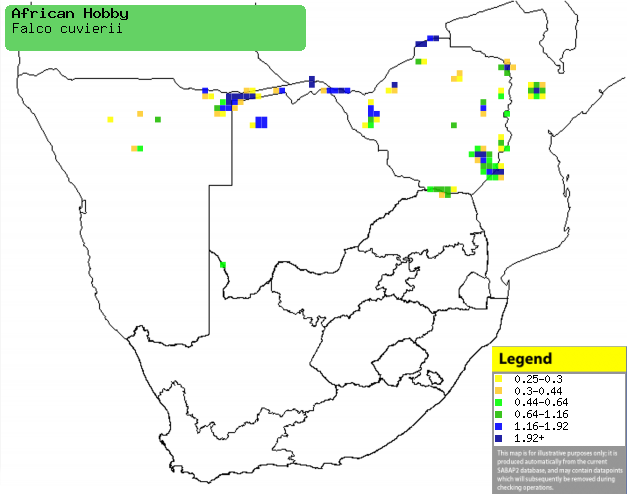|
Falco cuvierii (African hobby,
African hobby falcon)
Afrikaanse boomvalk [Afrikaans]; Kakodi (generic term for
sparrowhawks, goshawks, kestrels and falcons) [Kwangali]; Afrikaanse boomvalk
[Dutch]; Faucon de Cuvier [French]; Afrikanischer baumfalke [German];
Ógea-africana [Portuguese]
Life
> Eukaryotes >
Opisthokonta
> Metazoa (animals) >
Bilateria >
Deuterostomia > Chordata >
Craniata > Vertebrata (vertebrates) > Gnathostomata (jawed
vertebrates) > Teleostomi (teleost fish) > Osteichthyes (bony fish) > Class:
Sarcopterygii (lobe-finned
fish) > Stegocephalia (terrestrial
vertebrates) > Tetrapoda
(four-legged vertebrates) > Reptiliomorpha > Amniota >
Reptilia (reptiles) >
Romeriida > Diapsida > Archosauromorpha > Archosauria >
Dinosauria
(dinosaurs) > Saurischia > Theropoda (bipedal predatory dinosaurs) >
Coelurosauria > Maniraptora > Aves
(birds) > Order: Falconiformes >
Family: Falconidae
Distribution and habitat
Occurs in patches across sub-Saharan Africa; within
southern Africa it is uncommon to rare in Zimbabwe, central
Mozambique, northern Botswana and the Caprivi Strip (Namibia), with isolated
records in central Namibia and Limpopo Province. It generally prefers tropical
woodland, savanna, the border between forest and savanna and heavily
disturbed, cultivated or urban areas; in southern Africa it tends to occupy palm savanna and broad-leaved woodland.
|
 |
|
Distribution of African hobby in southern Africa,
based on statistical smoothing of the records from first SA Bird Atlas
Project (©
Animal Demography unit, University of
Cape Town; smoothing by Birgit Erni and Francesca Little). Colours range
from dark blue (most common) through to yellow (least common). |
Movements and migrations
Summer breeding visitor, arriving in southern
Africa in about September and leaving in April. Its non-breeding
grounds probably lie to the north, however their exact location is
unknown.
Food
It mainly eats insects, supplemented with small birds and
bats, hunting aerially either close to the ground or high up in the canopy,
striking prey aerially with great speed. The following food items have been recorded
in its diet:
Breeding
- Little known in southern Africa, although it is known to be monogamous and
territorial.
- It uses the stick nest of another bird, such as
Wahlberg's eagle,
Black kite,
Cape crow,
Pied crow and
White-breasted
cormorant, usually at the top of a prominent tree.
- Egg-laying season is from September-November.
- It lays 2-4 eggs, which are mainly incubated by the female for roughly
30 days.
- The chicks are brooded and fed by the female with food given to her by
the male, leaving the nest after about 30 days.
Threats
Probably not threatened.
References
-
Hockey PAR, Dean WRJ and Ryan PG 2005. Roberts
- Birds of southern Africa, VIIth ed. The Trustees of the John Voelcker
Bird Book Fund, Cape Town.
|
